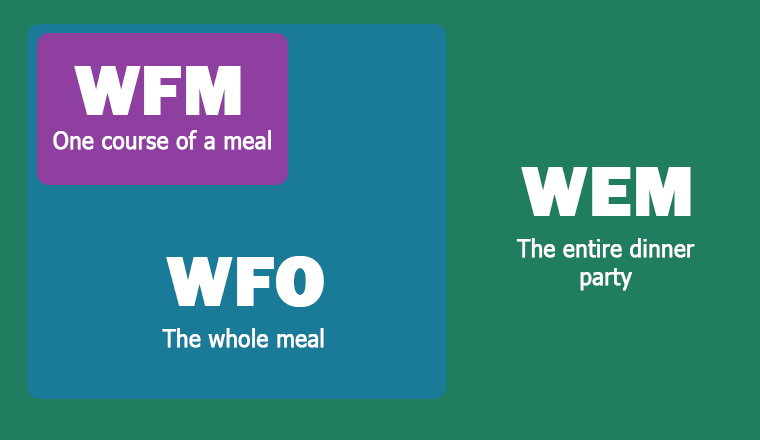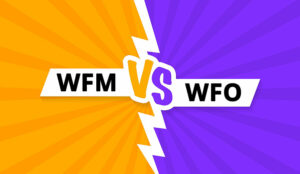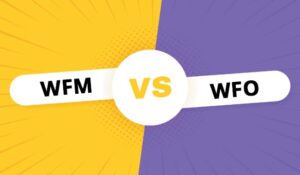Anyone in the planning community will have heard the terms workforce management (WFM) and workforce optimization (WFO).
But what is the difference between WFO and WFM?
In this article we will define workforce management and workforce optimization, outline the key differences, and even take a quick look at workforce engagement management (WEM).
What Is Workforce Management (WFM)?
The term workforce management, or WFM, encompasses all the strategies, processes, and systems used by contact centres to manage their workforce.
The main goal of workforce management is to make sure that the right people are in the right place at the right time so the contact centre can meet customer demand and operational goals.
WFM processes include each of the following:
- Forecasting contact volumes
- Scheduling staff around your forecast contact volumes
- Managing on a day-to-day basis (intraday management), in case of unexpected rises in contact volumes or absenteeism
- Creating a Business Continuity Plan (BCP)
If you want to know more, watch this great video where Alex O’Donovan at Business Systems, Paul Turner at Genesys, and Nikki Quinn at Playvox explain what workforce management (WFM) is in the contact centre.
To understand more about the basic WFM components, read our article: What Is Workforce Management (WFM)?
What Is Workforce Optimization (WFO)?
Workforce optimization, or WFO, is a term that encompasses all the strategies, processes, and systems used by contact centres to improve efficiency, costs, customer satisfaction, and performance.
The main goals of workforce optimization extend beyond simply optimizing workforce management and scheduling. In essence, WFO seeks to enhance the employee life cycle, by focusing on both employee development and operational efficiency.
WFO processes include each of the following:
- Workforce management (WFM)
- Quality management
- Customer interaction metrics
- Gamification
- Performance management
- Training and development
Key Differences: Workforce Management (WFM) vs Workforce Optimization (WFO)
Workforce management (WFM) and workforce optimization (WFO) are two related but distinct concepts. Although they both encompass workforce efficiency and productivity, the key difference between WFO and WFM is their scope and objectives.
Day-to-day resource management and workforce scheduling is primarily dealt with by workforce management (WFM).
WFO, however, takes a broader approach as it encompasses a multitude of strategies and tools aimed at optimizing workforce performance, enhancing CX, and driving overall business success.
To look at it in more detail, WFM and WFO differ in the following areas:

1. Scope and Focus
WFM primarily looks at the operational aspects of managing a workforce, and involves tasks such as forecasting volumes, scheduling, attendance tracking, and staff levels.
WFO takes a broader view, and although it covers the operational aspects of WFM, it is more strategic, encompassing areas of employee performance, employee engagement, CX, and compliance.
2. Areas Covered
WFM typically encompasses the day-to-day management of the workforce to meet contact centre goals. Generally it covers areas such as scheduling, forecasting, adherence, real-time monitoring, and staff levels.
WFO encompasses WFM, but also expands this to cover areas such as quality, compliance, performance management, training and coaching, and CX.
3. Purpose and Goals
The goal of WFM is to optimize staffing levels, reduce costs, improve customer service, and enhance overall operational efficiency.
The goal of WFO is not only to ensure operational efficiency but also to improve productivity, customer satisfaction, and compliance with regulations. It aims to create a more holistic and effective workforce by focusing on training, feedback, and continuous improvement.
You can also watch this video where Paul Turner at Genesys, Nikki Quinn at Playvox, and Alex O’Donovan at Business Systems discuss the difference between Workforce Management (WFM) and Workforce Optimization (WFO).
You may also have heard the term workforce engagement management, or WEM, thrown around when discussing WFM and WFO.
What Is Workforce Engagement Management (WEM)?
Workforce engagement management, or WEM, is a step up from workforce optimization and encompasses the strategies, processes, and systems used by contact centres to engage and empower their employees in order to meet business objectives.
Going beyond traditional WFM practices, the main goal of WEM is to create an environment where employees are productive, motivated, engaged and aligned with the goals of the contact centre.
WEM processes include each of the following:
- Hiring
- Onboarding
- Assigning KPIs
- Managing
- Motivating
- Rewarding
- Call recording
- Optimization
Key Differences: Workforce Management (WFM) vs Workforce Optimization (WFO) vs Workforce Engagement Management (WEM)
Workforce engagement management, workforce management (WFM) and workforce optimization (WFO) are related but distinct concepts.
They all encompass similar elements but build upon then in terms of scope and objectives.

A great way to think about it was suggested by Dave Hoekstra at Calabrio, who said:
“WFM is a part of the whole. Think of WFM as one course of a meal, and WFO is the whole meal.
“Well, we’ve now even moved to the new realm of WEM, where we might even be talking about the entire dinner party, as opposed to just the meal, where everything comes together.”
For more information on the difference between WFM, WFO and WEM, you should watch this video with Dave Hoekstra at Calabrio and Paul Turner at Genesys.
We have some great articles on these topics that you should read next:
- What WFM Tools Are Available?
- Workforce Optimization: 11 Ways to Improve Your Contact Centre Schedules
- Top Tips for Improving Your Workforce Engagement Strategy
Author: Robyn Coppell
Reviewed by: Jonty Pearce
Published On: 6th Sep 2023 - Last modified: 22nd Jul 2024
Read more about - Technology, Calabrio, CX, Dave Hoekstra, Editor's Picks, Employee Engagement, Genesys, Paul Turner, Playvox, Staffing, Workforce Management (WFM)





















